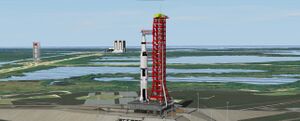Saturn V: Difference between revisions
imported>Tschachim m (typo) |
imported>Mark Grant No edit summary |
||
| Line 5: | Line 5: | ||
The largest production model of the Saturn family of rockets, the Saturn V was designed under the direction of Wernher von Braun at the Marshall Space Flight Center in Huntsville, Alabama, with Boeing, North American Aviation, Douglas Aircraft Company, and IBM as the lead contractors. It remains the most powerful launch vehicle ever brought to operational status, from a height, weight and payload standpoint, although the Russian Energia, which flew only two test missions, had slightly more takeoff thrust. | The largest production model of the Saturn family of rockets, the Saturn V was designed under the direction of Wernher von Braun at the Marshall Space Flight Center in Huntsville, Alabama, with Boeing, North American Aviation, Douglas Aircraft Company, and IBM as the lead contractors. It remains the most powerful launch vehicle ever brought to operational status, from a height, weight and payload standpoint, although the Russian Energia, which flew only two test missions, had slightly more takeoff thrust. | ||
A number of alternate Saturn vehicles<cite>SATURNV_STUDIES</cite> were proposed based on the Saturn V, ranging from the [[Saturn INT-20]] with an [[ | The rocket consisted of three stages. The [[S-IC]] had five [[F-1]] engines, burning liquid oxygen and kerosene, the [[S-II]] stage mounted above that had five [[J-2]] engines, burning liquid hydrogen and oxygen. The [[S-IVB]] stage had one J-2 engine, and was responsible both for the final part of the launch to put the spacecraft in orbit, and for the [[TLI]] burn to boost them on a trajectory that would take them to the Moon. | ||
A number of alternate Saturn vehicles<cite>SATURNV_STUDIES</cite> were proposed based on the Saturn V, ranging from the [[Saturn INT-20]] with an [[S-IVB]] stage and interstage mounted directly onto an [[S-IC]] stage, through to the [http://www.astronautix.com/lvs/satnv23l.htm Saturn V-23(L)] which would not only have five F-1 engines in the first stage, but also four strap-on boosters with two F-1 engines each: giving a total of ''thirteen'' F-1 engines firing at launch! | |||
<biblio force=false> | <biblio force=false> | ||
Revision as of 15:04, 14 December 2006

The Saturn V (pronounced 'Saturn Five,' popularly known as the Moon Rocket) was a multistage liquid-fuel expendable rocketSATURNV_FLIGHTMAN used by NASA's Apollo and Skylab programs.
The largest production model of the Saturn family of rockets, the Saturn V was designed under the direction of Wernher von Braun at the Marshall Space Flight Center in Huntsville, Alabama, with Boeing, North American Aviation, Douglas Aircraft Company, and IBM as the lead contractors. It remains the most powerful launch vehicle ever brought to operational status, from a height, weight and payload standpoint, although the Russian Energia, which flew only two test missions, had slightly more takeoff thrust.
The rocket consisted of three stages. The S-IC had five F-1 engines, burning liquid oxygen and kerosene, the S-II stage mounted above that had five J-2 engines, burning liquid hydrogen and oxygen. The S-IVB stage had one J-2 engine, and was responsible both for the final part of the launch to put the spacecraft in orbit, and for the TLI burn to boost them on a trajectory that would take them to the Moon.
A number of alternate Saturn vehiclesSATURNV_STUDIES were proposed based on the Saturn V, ranging from the Saturn INT-20 with an S-IVB stage and interstage mounted directly onto an S-IC stage, through to the Saturn V-23(L) which would not only have five F-1 engines in the first stage, but also four strap-on boosters with two F-1 engines each: giving a total of thirteen F-1 engines firing at launch!
<biblio force=false>
</biblio>